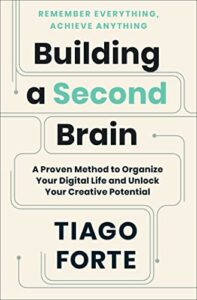 There’s a lot to like about Tiago Forte’s Building a Second Brain if you are a knowledge worker of any sort. In today’s world that’s most of us. Like any ambitious work, it’s a mix of strengths and weaknesses. Understand the limitations and take advantage of the wealth of good ideas and advice.
There’s a lot to like about Tiago Forte’s Building a Second Brain if you are a knowledge worker of any sort. In today’s world that’s most of us. Like any ambitious work, it’s a mix of strengths and weaknesses. Understand the limitations and take advantage of the wealth of good ideas and advice.
The book grew out of Forte’s own efforts to cope with the flood of information that we all swim in. That led to a course/coaching practice to share his insights with others wrestling with similar challenges. Add a growing online platform and you end up with a book deal. As some wags have put it, Forte is trying to lay claim in the Personal Knowledge Management space to the position that David Allen grabbed in the personal productivity realm a few years back.
If you opt for the conventional publishing model, you’re bound by the current assumptions and expectations of that model. Yes, you can compress much of the value of the book into a handful of blog posts or articles. Yes, you will be expected to insert a collection of anecdotes about the famous or important people demonstrating elements of your system in their work. Blame that on Malcolm Gladwell. Forte is working within the constraints of the market that exists.
You have a different set of questions as a potential reader. Does this particular package suit your constraints for adding to your knowledge base? Perhaps you would do better seeking out those blog posts. Or, your time/value tradeoff makes a course environment a better choice. Having good ideas available in multiple formats and environments is a feature not a bug.
I’m not a particular fan of the Second Brain metaphor. Unfortunately, it’s hot right now and marketing momentum takes precedence over actual relevance. If it appeals to you, great. If it doesn’t, focus on the examples and general discussion of PKM issues and principles.
In point of fact, I first encountered Forte’s ideas in his online environment. I paid for access to his online writing. I chose not to invest in his online course. The cost of adding the book itself to my knowledge environment was trivial. The cost of my time and attention to work through the book (a couple of times) was significantly less than the value I’ve realized.
I’ve taken the time to walk through this tradeoff analysis because it makes a point about PKM; you are in control and it is your responsibility to be in control of your knowledge environment. I’ve been advocating for PKM since at least 2005 ([Why You Need a Personal Knowledge-Management Strategy). I might be envious that Forte is seeing traction for these ideas that I never dreamed of, but the universe is a better place for it.
The principal value of Building a Second Brain is as an extended case study/example of one successful strategy for establishing and working within a PKM environment. Forte is at this strongest when he shares and works through examples of how his system works for him. When he tries to meet the Malcolm Gladwell expectations, he has a tendency to reach a bit farther than he should. For example, at one point, Forte claims that
every change in how we use technology also requires a change in how we think. To properly take advantage of the power of a Second Brain, we need a new relationship to information, to technology, and even to ourselves.
I think you can safely ignore that claim and still get full value out of the book. I’ll close with the best advice that Forte offers
As your needs change, give yourself the freedom to discard or take on whichever parts serve you. This isn’t a “take it or leave it†ideology where you must accept all of it or none of it. If any part doesn’t make sense or doesn’t resonate with you, put it aside. Mix and match the tools and techniques you’ve learned in this book to suit your needs.